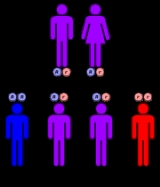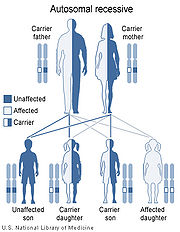
Papillon-Lefevre disease
Encyclopedia
Papillon–Lefèvre syndrome (PLS), also known as palmoplantar keratoderma with periodontitis, is an autosomal
recessive genetic disorder
caused by a deficiency in cathepsin C
.
. The severe destruction of periodontium results in loss of most primary teeth by the age of 4 and most permanent teeth by age 14. Hyperkeratosis of palms and soles of feet appear in first few years of life.

Mutations in the cathepsin C
gene (CTSC), located at human chromosome
11q14.1-q14.3
, are the cause of PLS. The disorder is inherited in an autosomal recessive manner. This means the defective gene responsible for the disorder is located on an autosome
(chromosome 11 is an autosome), and two copies of the defective gene (one inherited from each parent) are required in order to be born with the disorder. The parents of an individual with an autosomal recessive disorder both carry
one copy of the defective gene, but usually do not experience any signs or symptoms of the disorder.
Autosome
An autosome is a chromosome that is not a sex chromosome, or allosome; that is to say, there is an equal number of copies of the chromosome in males and females. For example, in humans, there are 22 pairs of autosomes. In addition to autosomes, there are sex chromosomes, to be specific: X and Y...
recessive genetic disorder
Genetic disorder
A genetic disorder is an illness caused by abnormalities in genes or chromosomes, especially a condition that is present from before birth. Most genetic disorders are quite rare and affect one person in every several thousands or millions....
caused by a deficiency in cathepsin C
Cathepsin C
Cathepsin C also known as dipeptidyl peptidase I is a lysosomal exo-cysteine protease belonging to the peptidase C1 family...
.
Characteristics
PLS is characterized by periodontitis and palmoplantar keratodermaPalmoplantar keratoderma
Palmoplantar keratodermas are a heterogeneous group of disorders characterized by abnormal thickening of the palms and soleAutosomal recessive and dominant, X-linked, and acquired forms have all been described.There are also acquired forms of the condition....
. The severe destruction of periodontium results in loss of most primary teeth by the age of 4 and most permanent teeth by age 14. Hyperkeratosis of palms and soles of feet appear in first few years of life.
Cause and Genetics

Mutations in the cathepsin C
Cathepsin C
Cathepsin C also known as dipeptidyl peptidase I is a lysosomal exo-cysteine protease belonging to the peptidase C1 family...
gene (CTSC), located at human chromosome
Chromosome
A chromosome is an organized structure of DNA and protein found in cells. It is a single piece of coiled DNA containing many genes, regulatory elements and other nucleotide sequences. Chromosomes also contain DNA-bound proteins, which serve to package the DNA and control its functions.Chromosomes...
11q14.1-q14.3
Chromosome 11 (human)
thumb|right|Chromosome 11 ChartChromosome 11 is one of the 23 pairs of chromosomes in humans. Humans normally have two copies of this chromosome. Chromosome 11 spans about 134.5 million base pairs and represents between 4 and 4.5 percent of the total DNA in cells...
, are the cause of PLS. The disorder is inherited in an autosomal recessive manner. This means the defective gene responsible for the disorder is located on an autosome
Autosome
An autosome is a chromosome that is not a sex chromosome, or allosome; that is to say, there is an equal number of copies of the chromosome in males and females. For example, in humans, there are 22 pairs of autosomes. In addition to autosomes, there are sex chromosomes, to be specific: X and Y...
(chromosome 11 is an autosome), and two copies of the defective gene (one inherited from each parent) are required in order to be born with the disorder. The parents of an individual with an autosomal recessive disorder both carry
Genetic carrier
A genetic carrier , is a person or other organism that has inherited a genetic trait or mutation, but who does not display that trait or show symptoms of the disease. They are, however, able to pass the gene onto their offspring, who may then express the gene...
one copy of the defective gene, but usually do not experience any signs or symptoms of the disorder.

